BY WILLIAM HARWOOD
STORY WRITTEN FOR CBS NEWS "SPACE PLACE" & USED WITH PERMISSION
Posted: October 27, 2004
PASADENA, Calif. - After years of anticipation, the Cassini spacecraft beamed back smog-piercing close-up images of Saturn's moon Titan late Tuesday, revealing a strange, striated landscape that both thrilled - and mystified - planetary scientists.
 This image taken by Cassini's visual and infrared mapping spectrometer clearly shows surface features on Titan. It is a composite of false-color images taken at three infrared wavelengths: 2 microns (blue); 2.7 microns (red); and 5 microns (green). A methane cloud can be seen at the south pole (top of image). This picture was obtained as Cassini flew by Titan at altitudes ranging from 100,000 to 140,000 kilometers (88,000 to 63,000 miles), less than two hours before the spacecraft's closest approach. The inset picture shows the landing site of Cassini's piggybacked Huygens probe. Credit: NASA/JPL/University of Arizona Download larger image version here |
Other than a 600-mile-wide formation near the south pole, few clouds are present and no large craters are apparent, indicating tectonic, volcanic or depositional processes are at work that have resurfaced the moon on a global scale.
But so far, there is no evidence of lakes or pools of liquid ethane and similar materials that many scientists believe must be present given the moon's ultra-low temperature, high atmospheric pressure and hydrocarbon chemistry.
In short, Titan's mysteries withstood Cassini's initial scientific assault.
"We've been saying for a long time now that Titan was the largest expanse of unexplored terrain in the solar system," said imaging team leader Carolyn Porco, a leading expert on Saturn's rings. "And what remains hidden under the atmosphere and under the haze, the conditions at its surface, its geological history and so on are, at least in my mind, the solar system's last great mystery."
Even though Cassini's cameras operated flawlessly and even though conditions were optimal for imaging, "I have to report that we are still mystified and we are not quite sure what we're looking at," Porco said. "There isn't much we are absolutely, definitively confident about right now."
She might as well have paraphrased Winston Churchill's 1939 comment about the former Soviet Union: "It is a riddle wrapped in a mystery inside an enigma."
Cassini entered orbit around Saturn in June after a seven-year voyage from Earth. The $3 billion spacecraft made its first of 45 planned flybys of Titan late Tuesday, streaking past the cloudy moon at an altitude of just 745 miles. Using filters to peer through the hydrocarbon haze that blankets the satellite, Cassini snapped dozens of pictures that raised as many questions as they answered.
"This image has been processed, it's been sharpened, it's been contrast enhanced and there it is," Porco said, displaying one such photo. "We don't know exactly what we're looking at. There are sharp boundaries between the dark regions and the bright regions, there ... are white things that stick out, they kind of look like islands sticking out of the dark material.
"But frankly, there is no topography in our images," she said. "We do not see shadows on the surface of Titan. And because we don't see shadows, we can't look at an image like this and immediately deduce topographic information, what's up and what's down. Everything here ... could be perfectly flat. Maybe what we're seeing is just bright material, dark material, all at the same level. But we don't know."
Radar data from Cassini will help fill in many of those blanks and researchers plan to present their initial findings Thursday. Scientists said the first processed image was spectacular.
 This image shows Titan in ultraviolet and infrared wavelengths. It was taken by Cassini's imaging science subsystem on Oct. 26 and is constructed from four images acquired through different color filters. Red and green colors represent infrared wavelengths and show areas where atmospheric methane absorbs light. These colors reveal a brighter (redder) northern hemisphere. Blue represents ultraviolet wavelengths and shows the high atmosphere and detached hazes. Titan has a gigantic atmosphere, extending hundreds of kilometers above the surface. The sharp variations in brightness on Titan's surface (and clouds near the south pole) are apparent at infrared wavelengths. The image scale of this picture is 6.4 kilometers (4 miles) per pixel. Credit: NASA/JPL/Space Science Institute Download larger image version here |
At today's briefing, Porco concentrated on the pictures. She said that despite the moon's lack of extensive cloud cover, "we've deduced that Titan is a super rotator, it means the cloud speeds, the wind speeds in the middle and the upper troposphere, are going faster than you would get if you just accounted simply for the conservation of angular momentum as a cloud basically developed from a convective parcel of air. This is the same case as for Venus."
But the most intriguing features to her were linear streaks on the surface that indicate some sort of active process at work.
"What we can confidently say about the structures we are seeing on the surface is there are linear trends, there are streaks or perhaps there are cracks in the bedrock ice of titan, we don't know," Porco said. "But there are linear features and we see this in lots of regions where we look in high resolution. And again, not quite exactly sure what it's telling us, whether it's a tectonic process we're looking at or it's (wind related).
"What we can say from those images is the surface seems to be a young surface. We see very few circular features that one might interpret as craters. In fact, that doesn't even mean they're not there. If the surface is coated at this viewing geometry with no shadows, if the surface was coated completely with a uniform material, we wouldn't see any craters anyway even if they were there.
"It's going to take combining all these data together, it's going to take our stereo imaging, which will give us topography, it's going to take a combination of the (infrared imaging spectrometer) and the radar in order to really pick out whether we're seeing highs or lows and so on. There's a lot of work left to do. Our reconnaissance of Titan, our exploration of Titan, is really just beginning."
Imaging spectrometer team leader Robert Brown said his instrument also showed "a lot of complex structure on Titan's surface, a lot of strong margins between bright and dark regions."
"We're not exactly sure what the composition of the bright and dark regions are but some of the preliminary indications we've gotten from VIMS (Visual Imaging Spectrometer) suggest that even though there are differences between bright and dark, which are roughly a factor of two, that the composition of those bright and dark regions are not all that different, which is not what we expected.
"It's a bit hard to understand because their albedos are so different," he said. "But one way that can happen is you could coat the bright material and the dark material with a material which would mask the composition of the substrate, but you could see through it partially. So it may be some sort of a coating effect."
For now, no one knows.
"I think we're going to have to wait several flybys," Porco said, "maybe even several years, before we get a really good indication of what's going on."
Titan up close
CASSINI PHOTO RELEASE
Posted: October 26, 2004
These raw, un-processed images of Saturn's moon Titan were taken by the Cassini spacecraft and transmitted to Earth on October 26. The pictures provide the closest views ever snapped of the hazy moon. Cassini flew 1,200 kilometers (745 miles) above the moon during the encounter.
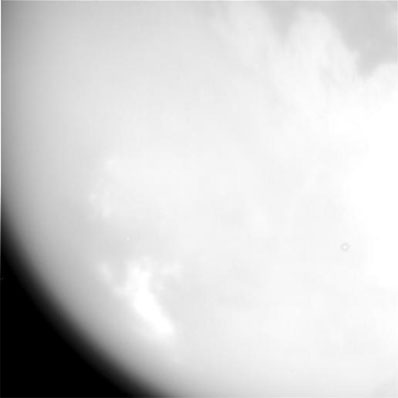 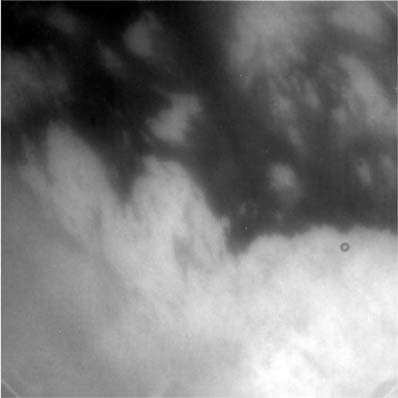 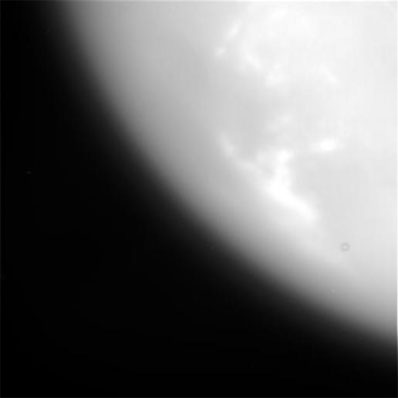 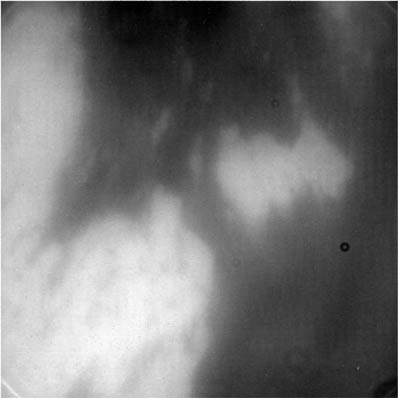 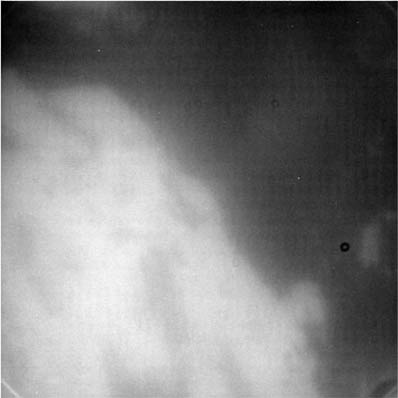 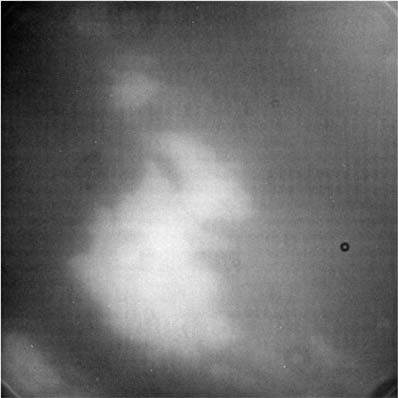 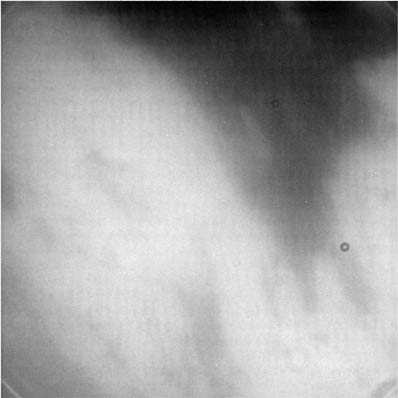 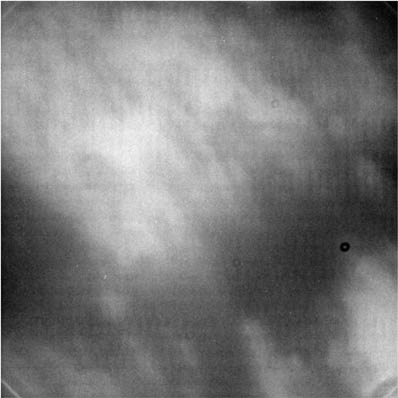 Credit: NASA/JPL/Space Science Institute |
